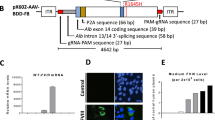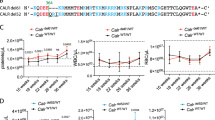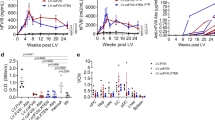Abstract
ADAMTS13 is a plasma metalloprotease that regulates the size of the von Willebrand factor (VWF) multimers. Genetic or acquired deficiency of ADAMTS13 causes thrombotic thrombocytopenic purpura (TTP) in humans. Plasma infusion is the treatment of choice for patients with congenital ADAMTS13 deficiency. However, this practice exposes patients to the risk of infections, allergies and fluid volume overload. The search for alternative treatments is required. Here, we tested the ability of systemically administered adenovirus encoding human ADAMTS13 to restore the deficient protein in the circulation of Adamts13−/− mice. Injection of the adenovirus efficiently transduced the liver, kidney, lung, heart and spleen, resulting in the secretion of ADAMTS13 into plasma. A reduced area of thrombi was observed when blood from Ad-ADAMTS13-treated mice was perfused over a collagen-coated surface in a parallel plate flow chamber compared with blood of Ad-βGal-treated controls. The secreted ADAMTS13 protein was functionally active even after 2 months from injection. The data provide the proof of principle for developing a novel therapy for the correction of ADAMTS13 deficiency in patients with hereditary TTP.
This is a preview of subscription content, access via your institution
Access options
Subscribe to this journal
Receive 12 print issues and online access
$259.00 per year
only $21.58 per issue
Buy this article
- Purchase on Springer Link
- Instant access to full article PDF
Prices may be subject to local taxes which are calculated during checkout





Similar content being viewed by others
References
Remuzzi G, Ruggenenti P, Bertani T . Thrombotic microangiopathies. In: Tisher CC, Brenner BM (eds). Renal Pathology with Clinical and Functional Correlations, 2nd edn, vol. 2. J.B. Lippincott Company: Philadelphia, PA, 1994, pp 1154–1184.
Galbusera M, Noris M, Remuzzi G . Thrombotic thrombocytopenic purpura—then and now. Semin Thromb Hemost 2006; 32: 81–89.
Furlan M, Robles R, Lammle B . Partial purification and characterization of a protease from human plasma cleaving von Willebrand factor to fragments produced by in vivo proteolysis. Blood 1996; 87: 4223–4234.
Levy GG, Nichols WC, Lian EC, Foroud T, McClintick JN, McGee BM et al. Mutations in a member of the ADAMTS gene family cause thrombotic thrombocytopenic purpura. Nature 2001; 413: 488–494.
Donadelli R, Banterla F, Galbusera M, Capoferri C, Bucchioni S, Gastoldi S et al. In-vitro and in-vivo consequences of mutations in the von Willebrand factor cleaving protease ADAMTS13 in thrombotic thrombocytopenic purpura. Thromb Haemost 2006; 96: 454–464.
Furlan M, Robles R, Galbusera M, Remuzzi G, Kyrle PA, Brenner B et al. von Willebrand factor-cleaving protease in thrombotic thrombocytopenic purpura and hemolytic-uremic syndrome. N Engl J Med 1998; 339: 1578–1584.
Tsai H-M, Lian EC-Y . Antibodies to von Willebrand factor-cleaving protease in acute thrombotic thrombocytopenic purpura. N Engl J Med 1998; 339: 1585–1594.
Barbot J, Costa E, Guerra M, Barreirinho MS, Isvarlal P, Robles R et al. Ten years of prophylactic treatment with fresh-frozen plasma in a child with chronic relapsing thrombotic thrombocytopenic purpura as a result of a congenital deficiency of von Willebrand factor-cleaving protease. Br J Haematol 2001; 113: 649–651.
Moake JL . Thrombotic microangiopathies. N Engl J Med 2002; 347: 589–600.
Byrnes JJ, Khurana M . Treatment of thrombotic thrombocytopenic purpura with plasma. N Engl J Med 1977; 297: 1386–1389.
Moake JL . Thrombotic thrombocytopenic purpura: survival by ‘giving a dam’. Trans Am Clin Climatol Assoc 2004; 115: 201–219.
Chauhan AK, Motto DG, Lamb CB, Bergmeier W, Dockal M, Plaimauer B et al. Systemic antithrombotic effects of ADAMTS13. J Exp Med 2006; 203: 767–776.
Fechner H, Haack A, Wang H, Wang X, Eizema K, Pauschinger M et al. Expression of coxsackie adenovirus receptor and alphav-integrin does not correlate with adenovector targeting in vivo indicating anatomical vector barriers. Gene Therapy 1999; 6: 1520–1535.
Einfeld DA, Schroeder R, Roelvink PW, Lizonova A, King CR, Kovesdi I et al. Reducing the native tropism of adenovirus vectors requires removal of both CAR and integrin interactions. J Virol 2001; 75: 11284–11291.
Remuzzi G, Galbusera M, Noris M, Canciani MT, Daina E, Bresin E et al. von Willebrand factor cleaving protease (ADAMTS13) is deficient in recurrent and familial thrombotic thrombocytopenic and hemolytic uremic syndrome. Blood 2002; 100: 778–785.
Gerritsen HE, Turecek PL, Schwarz HP, Lammle B, Furlan M . Assay of von Willebrand factor (vWF)-cleaving protease based on decreased collagen binding affinity of degraded vWF. Thromb Haemost 1999; 82: 1386–1389.
Motto DG, Chauhan AK, Zhu G, Homeister J, Lamb CB, Desch KC et al. Shigatoxin triggers thrombotic thrombocytopenic purpura in genetically susceptible ADAMTS13-deficient mice. J Clin Invest 2005; 115: 2752–2761.
Galbusera M, Remuzzi A, Benigni A, Rossi C, Remuzzi G . A novel interpretation of the role of von Willebrand factor in thrombotic microangiopathies based on platelet adhesion studies at high shear rate flow. Am J Kidney Dis 2000; 36: 695–702.
Niiya M, Endo M, Shang D, Zoltick PW, Muvarak NE, Cao W et al. Correction of ADAMTS13 deficiency by in utero gene transfer of lentiviral vector encoding ADAMTS13 genes. Mol Ther 2009; 17: 34–41.
Laje P, Shang D, Cao W, Niiya M, Endo M, Radu A et al. Correction of murine ADAMTS13 deficiency by hematopoietic progenitor cell-mediated gene therapy. Blood 2009; 113: 2172–2180.
Mok H, Palmer DJ, Ng P, Barry MA . Evaluation of polyethylene glycol modification of first-generation and helper-dependent adenoviral vectors to reduce innate immune responses. Mol Ther 2005; 11: 66–79.
Campos SK, Barry MA . Current advances and future challenges in Adenoviral vector biology and targeting. Curr Gene Ther 2007; 7: 189–204.
Blagbrough IS, Zara C . Animal models for target diseases in gene therapy—using DNA and siRNA delivery strategies. Pharm Res 2009; 26: 1–18.
Allocca M, Doria M, Petrillo M, Colella P, Garcia-Hoyos M, Gibbs D et al. Serotype-dependent packaging of large genes in adeno-associated viral vectors results in effective gene delivery in mice. J Clin Invest 2008; 118: 1955–1964.
Acknowledgements
We are grateful to Professor ZM Ruggeri (The Scripps Research Institute, La Jolla, CA, USA) for providing recombinant human VWF A1A2A3 domains and the anti-A3 domain monoclonal antibody. We are deeply indebted to Dr A Sonzogni for helping us with liver histological analysis. We also thank Dr Carla Zoja for her invaluable helpful discussion and criticism. Plasmids used for adenoviral construction and S8 cells are a kind gift from Novartis Pharma. The study is partially supported by a grant from the Istituto Superiore di Sanità, Roma, Italy. Piera Trionfini is a recipient of a fellowship from Fondazione Aiuti per la Ricerca sulle Malattie Rare (ARMR), Bergamo, Italy.
Author information
Authors and Affiliations
Corresponding author
Additional information
Supplementary Information accompanies the paper on Gene Therapy website (http://www.nature.com/gt)
Supplementary information
Rights and permissions
About this article
Cite this article
Trionfini, P., Tomasoni, S., Galbusera, M. et al. Adenoviral-mediated gene transfer restores plasma ADAMTS13 antigen and activity in ADAMTS13 knockout mice. Gene Ther 16, 1373–1379 (2009). https://doi.org/10.1038/gt.2009.98
Received:
Revised:
Accepted:
Published:
Issue Date:
DOI: https://doi.org/10.1038/gt.2009.98



